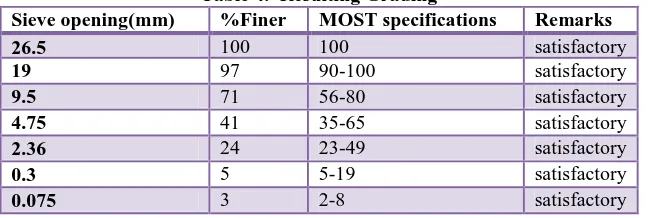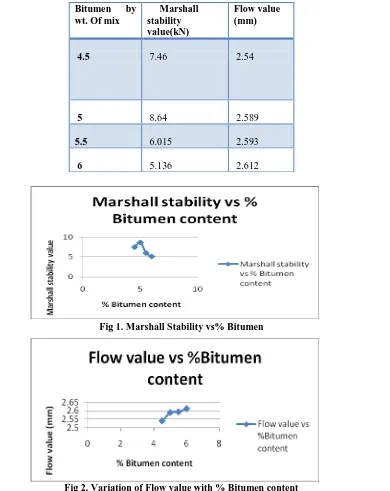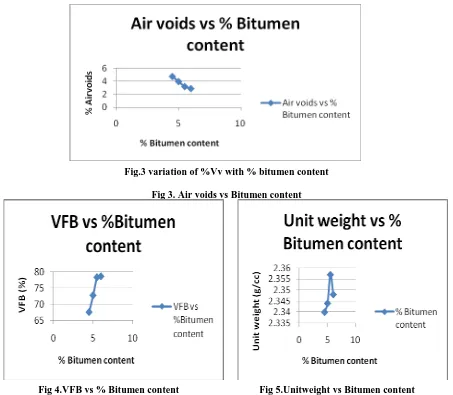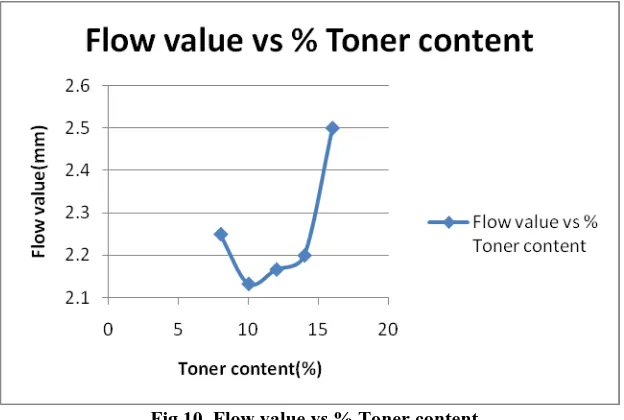e-ISSN: 2278-067X, p-ISSN: 2278-800X, www.ijerd.com
Volume 10, Issue 3 (March 2014), PP.67-72
Toner Modified Bitumen-A better method of disposal of
spent Toner
Rema Devi M
1, Leni Stephen
2, Mini M I
31 Professor, Dept of Civil Engineering, M A College of Engineering, Kothamangalam/M G university,
2 Professor, Dept of Civil Engineering, M A College of Engineering, Kothamangalam/M G university
3
Professor, Dept of Civil Engineering, M A College of Engineering, Kothamangalam/M G university
Abstract:- Use of waste toner from copiers and printers as a binder modifier in road construction is presented in
this paper. Various properties of bituminous mixes using ordinary bitumen and toner modified bitumen were studied. Since the properties are improved, this can be considered as a better solution for the disposal of waste toner.
Keywords:- Toner, bitumen, penetration value, softening point, optimum bitumen content, mix design.
I.
INTRODUCTION
Waste toner from copiers and printers is a serious solid waste, difficult to dispose. It is usually dumped in to landfills since there is no other way of utilising this material. As a fine powder, toner can remain suspended in the air for some period, and is considered to have health effects compared to dust. This work deals with the use of toner modified bitumen for road constructions. The various properties of ordinary bitumen and toner modified bitumen are compared. Marshall stability value, flow value and other parameters of bituminous mixes(ordinary and toner modified) were also compared.
II.
LITERATURE
REVIEW
A cooperative research project, 7-3933, undertaken by the Texas Department of Transportation and The University of Texas at Austin[3], investigated the feasibility and potential benefits of utilising waste toner in hot mix asphalt. It is concluded that the properties of asphalt are improved a lot when modified with toner. Galliford (2004) explained the ill effects of toner. “Use of waste in Asphalt concrete” published by Centre for Transportation Research[4] described the mix designs with toner modified bitumen. Ayers,M.E.etal.[5] explained the incorporation of waste Toner in asphalt concrete highways.
III.
MATERIALS
AND
PROPERTIES
The materials used for the preparation of mix are
A. Aggregates.
Aggregate was obtained from a local quarry and the physical properties were tested in the laboratory and are given in Table 1. To get the required gradation, three grades (A,B,C) of aggregates were used. Cement was used as a filler material.
Table 1. Properties of Aggregates
B. Bitumen.
80/100 bitumen was obtained from Cochin refineries Ltd. The physical properties of this bitumen are shown in Table 2.
Sl.No Property Test result Remarks
1 Aggregate crushing value 30% satisfactoy
2 Impact value 28%
3 Specific gravity 2.73
4 Los Angeles Abrasion value 42%
5 Flakiness Index 13.48%
6 Elongation index 8.87%
7 Water absorption 0.4%
8 Soundness 10%
C. Toner.
Spent toner obtained from photocopiers.
D. Filler.
Ordinary Portland cement was used as the filler material.
Table.2 Properties Of Ordinary Bitumen
Sl.No Property Test result Remarks
1 Softening point of bitumen 410C satisfactory
2 Ductility Value 82cm
3 Specific gravity of bitumen 1.0
4 Penetration Value 65
5 Viscosity of bitumen 72sec
E. Marshall method of mix design
The mix design should aim at an economical blend, with proper gradation of aggregates and adequate proportion of bitumen so as to fulfil the desired properties of mix.
1) Proportioning of aggregates.
It is done by Rutherfoth method and different proportions are shown below: Aggregate A- 15%
Aggregate B- 32% Aggregate C- 51% Cement- 2% (filler)
The final gradation of the mix with the requirement of MOST (Ministry Of Surface Transport) is shown in Table 4
Table 4. Resulting Grading
Sieve opening(mm) %Finer MOST specifications Remarks
26.5 100 100 satisfactory
19 97 90-100 satisfactory
9.5 71 56-80 satisfactory
4.75 41 35-65 satisfactory
2.36 24 23-49 satisfactory
0.3 5 5-19 satisfactory
0.075 3 2-8 satisfactory
Toner was added to bitumen at different percentages by weight of bitumen and the properties were studied and are shown in Table 5
Table5. Properties of Toner modified Bitumen
Toner (%) Penetration(mm) Softening point(0C) Sp.Gravity Viscosity(sec)
0 93 40 1.0204 93
8 45.6 48.5 1.0249 104
10 33.33 52.2 1.0296 110
12 27.67 52.5 1.0347 119
14 18 53.25 1.0365 128
16 12.33 68.40 1.0489 135
1) Preparation of Test Specimen
The standard specimens were prepared with ordinary bitumen and toner modified bitumen at different percentages of
Toner. Three specimens of each were prepared and tested.
2) Properties of Compacted specimens.
The various properties tested are specific gravity, percentage air voids (VV), percentage Voids in
Table 5 Marshall Properties of Specimens with Ordinary Bitumen Bitumen
by weight of mix (%)
Specific gravity
Voids %
Bulk average
Theo. max.
VMA
VFB
Vv
4.5 2.34 2.4 14.598 67.590 4.731
5 2.344 2.375 14.587 72.790 3.969
5.5 2.357 2.408 14.850 78.380 3.210
6 2.348 2.405 14.956 78.670 2.901
IV.
TEST
RESULTS
AND
ANALYSIS
Marshall Stability value and flow value of specimens with ordinary bitumen is shown in Table 6.
Table 6 Marshall Test Results (Ordinary Bitumen)
Fig 1. Marshall Stability vs% Bitumen
Fig 2. Variation of Flow value with % Bitumen content
Bitumen by
wt. Of mix
Marshall stability value(kN)
Flow value (mm)
4.5 7.46 2.54
5 8.64 2.589
5.5 6.015 2.593
Fig.3 variation of %Vv with % bitumen content
Fig 3. Air voids vs Bitumen content
Fig 4.VFB vs % Bitumen content Fig 5.Unitweight vs Bitumen content
The optimum bitumen content is calculated by taking the average of the following bitumen contents found from the respective graphs.
Bitumen content corresponding to maximum stability
Bitumen content corresponding to maximum unit weight
Bitumen content corresponding to the median of designed limits of percentage voids (Vv) in the total mix.
The value of optimum bitumen content is 5.2%
With this optimum bitumen content the various properties of toner modified bituminous mixes were tested for different percentages of toner content and is shown in Table 7.
Table7. Marshall Properties Of Toner Modified Bituminous Mix.
Particulars Toner %
8 10 12 14 16
Unit weight 2.292 2.317 2.351 2.309 2.235
%Air voids 9.875 9.603 7.840 6.560 4.056
VMA(%) 19.23 17.331 8.967 10.609 13.447
Marshall stability value (kN)
9.625 12.670 10.00 7.44 5.59
Flow value(mm)
2.250 2.133 2.167 2.20 2.50
Fig 6. Marshall stability value vs % Toner content Fig 7.Density vs % tonercontent
FIG 8.VMA VS TONER CONTENT(%) FIG 9.AIR VOIDS VS TONER CONTENT(%)
Fig 10 .Flow value vs % Toner content
V.
CONCLUSION
With a view to improve the pavement characteristics of the flexible pavement using Toner midified Bitumen, the following conclusions are made.
The properties of Bitumen which mainly because rutting action are improved using Toner modified Bitumen.
Considerable increase in Marshall Stability value at 10% Toner.
Above all the waste spent Toner which is a pollution menace can find its use in road construction and thereby solving the problem of pollution to a certain extent.
REFERENCES
[1]. IRC SP:16-2004,Guide lines for surface evenness of highway pavements.
[2]. IRC SP: 53-2002, Guide lines on use of polymer and rubber modified bitumen in road construction [3]. Yildrim,Y., The Modified Asphalt
Demonstratiproject (2007), http:///www.utexas.edu/research/ctr/pdf_report/5_3933_01_2.pdf
[4]. Korkmaz, Arnagan, Prozzi, Jorge,Y.,Yetkin(19980, Toner midified Asphalt, Transportation Research Board,ISSN:0361-
[5]. 1981,Volume1638/1998,pp120-128



